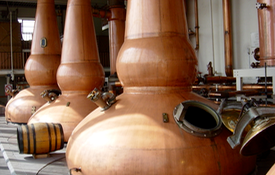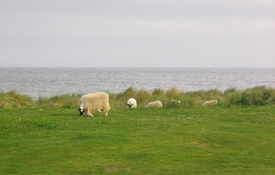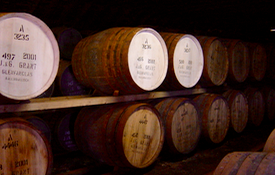
Scotch Whisky – a Shiny Pot Still
It’s no secret that Scotch Whisky is more popular now than ever, with no ceiling in sight. Today, it is hard to find a bar or restaurant that does not offer at least a modest selection of Scotch Whisky. Despite the growing number of Whisky converts, many remain confused by the perception of rituals surrounding its service and the peculiar Gaelic place names that adorn many Scotch Whisky labels.
Some of the uneasiness in venturing into the world of Scotch Whisky is understandable as a vast number of labels are available, the names are unfamiliar to Americans, and the industry itself wraps the brands in a skillfully woven tapestry of lore and mystery. While all of the romance spun by Whisky’s marketing agents is designed to lure the potential consumer – which it does very well – it does frighten some.
There is no reason to fear Scotch Whisky. Be assured that there is no secret handshake, no Gaelic password, and no initiation rights to be performed (although a kilt doesn’t hurt). Your curiosity for new flavors and experiences is all that is required. If you have made the leap to distilled spirits and acclimated to their inherent strength, easing into Whisky will be easy. If you are a wine lover flirting with the idea of discovering Whisky, come on in – the water is warm.
Tackling all of the nuances, history, and lore of Scotch Whisky could easily be a life’s work (and what a life it would be…). However, if you choose tackle these 20 factoids, you’ll be well on your way.
Mastering Scotch Whisky (in 20 easy steps)
1. What is Scotch? First, know that Scotch is purely Scottish. It is not a style of Whisky but rather simply a Whisky that is made in the nation of Scotland. It must also be aged in oak barrels for at least three years to be called Scotch Whisky legally – more on barrel aging later.
2. Varieties of Scotch Whisky. Scotch Whisky is typically divided into four categories: Single Malt, Grain, Blended, and Blended Malt (sometimes called Pure Malt or, by its former moniker, Vatted Malt). Blended Whisky is by far the largest category by volume and sales. Blended Whiskies are a blend of Grain Whiskies and Malt Whisky. Brands such as Johnnie Walker, Dewars, and Chivas are popular blends. Blended malts are a blend of two or more single malts.
3. What does Single Malt mean? Single refers to a single distillery. Malt is the sole grain material used to produce the Whisky. So, a single malt is a Whisky made at one distillery and made with 100% malted barley. Simple.

Relaxing with Scotch Whisky
4. Scotch Whisky Regions. For centuries, the Scottish Whisky industry has sub-divided the nation for tax purposes. Over time, vague regional styles emerged and remain to some degree today. While the decisions made by the individual distiller have more impact on the subsequent Whisky than the distillery address, it is useful to familiarize yourself with Scotch Whisky’s regional styles: Lowland Whiskies are the most delicate and lightest in the body. They do differ from other Scottish malts, as they are triple-distilled as opposed to double-distilled, as are all other Scotch malts. Island malts, most notably Islay, are noted for their assertive notes of peat and notes of the sea. While these would logically be the toughest malts to get cozy with, they are presently wildly popular. The Highland region encompasses the largest number of distilleries. It is commonly further subdivided, with the Speyside region being the most famous zone. Speyside malts are rich with malted barely flavors and noted for being slightly sweet and fruity. Campbeltown, a dangling peninsula on the western coast, was once a thriving distilling center, but now it is home to just three distilleries.
5. Where’s the “E”? Scotch Whisky has traditionally been spelled without an “E” while Irish Whiskey uses an E. No special reason for the difference, although some Irish producers have suggested (in jest) that the Scots are too thrifty to spring for the additional vowel.
6. Age statements, what do they mean? Most Single Malts wear an age statement boldly printed on the label. If the label says 12 years old (or any other age), it means that 100% of the Whisky in that bottle has aged in an oak barrel for at least 12 years and not one day less. It’s worthwhile mentioning that there is a huge push by Whisky distillers and marketers to create no-age-statement (NAS) Whiskies. Of course, these NAS Whiskies can comprise Whiskies of any age, provided it has reached a minimum of three years of age. Many believe the the rise of NAS Whisky is a sure sign of the coming apocalypse, while the brands are surely telling a different story. The truth likely lies somewhere in between, and most importantly, these NAS Whiskies must be examined individually rather as a group. Some of these NAS Whiskies are damn fine spirits, while others are clearly a cheap trick to sell Whisky that has yet to mature.
7. Does Scotch Whisky age in the bottle like wine? No. Whisky is aged in oak barrels. Once it makes it into a bottle, the aging stops, and the spirit’s flavor and aroma profile is captured.
8. What kinds of barrels are used to mature Scotch Whisky? Barrel aging is absolutely essential to Whisky. Like all Spirits, Whisky is clear and colorless when it comes off the still. All of the natural color observed in Whisky comes from the barrel – as do many of its aromas and flavors. The majority of barrels used for aging Scotch Whisky were originally used to age Bourbon in the USA. Scotch Whisky is (almost) always aged in used barrels, while Bourbon is required to be aged in new oak barrels. It’s a great symbiotic relationship that exists between Bourbon and Scotch Whisky producers.
Other types of barrels are also utilized, with ex-Sherry being the second most common barrel type. There are no rules regarding the former use of an oak barrel.
9. Finished in “Port Wood”. What does this mean? In the past few decades, the practice of special wood “finishing” has become popular. This is a creative way for a distiller to add an additional flavor component to their Whisky. A year or two in barrels that have freshly housed Port, Madeira, Rum, Sherry, or any Wine or Spirit adds a bright and distinctive flavor and aroma component. This is far from a marketing gimmick, as it is an additional tool utilized by the distiller to make tasty and unique Whiskies for us to enjoy.
10. What is “Single Cask” Whisky? As the name suggests, in a very literal sense a Whisky that comes from one single cask as opposed to a marriage of casks as is the norm. Most single-cask Whiskies are also typically free of added color and are bottled at “cask strength.”
11. Cask Strength Whisky: what does this mean? It simply means that the Whisky was bottled at the cask’s (or group of casks’) natural strength. Most spirits are diluted with water at the time of bottling to meet a uniform standard, with 40% alcohol by volume being the most common. Cask-strength Spirits are not diluted and often not altered in any way.
12. How strong is Whisky? Whisky must be bottled at a minimum of 40% alcohol by volume, translating to 80 proof in the US. This is the standard strength found in most dry Spirits (Liqueurs are typically bottled at a lesser strength.)

Scotch Whisky Resting
13. Is older Whisky better? Whisky distillers have an ascending scale of prices for their Whisky offerings. The older the Whisky, the higher the price. Logically, one would assume that an older Whisky with a higher price tag is better than a younger, cheaper Whisky from the same distillery. While this is sometimes true, it is far from a rule. It is a matter of personal taste and preference. There are many instances that I prefer a Whisky in the middle of a distillery’s age range as opposed to the oldest. In a few cases, I prefer the youngest Whisky. Keep an open mind and trust your palate. There certainly does come a point of diminishing returns where the Whisky has been in the barrel to the extent that it has lost its original flavor profile and vigor and has become weighed down with the flavor of wood.
14. What is Peat? Peat is an organic fuel cut from the turf. This was once a vital home heating and cooking fuel in Scotland and throughout the British Isles. Peat was also burned to dry malted barley. While a great and cheap fuel, peat has a definite “reek” when burned. As you can imagine, this greatly influenced the malted barley and the resulting Whisky. Learn more about Peat HERE.
15. Ice. I say no, but many say yes. The bottom line is that it’s your drink; you paid for it, so have it as you will. However, you should be aware that ice dulls the aromatics and the palate.
16. Water. I answer with an emphatic yes. In most cases, water can make a Whisky more vibrant on the palate and the aromatics more lively and pronounced. This fact is counterintuitive to many, as diluting most liquids with water dulls flavors rather than elevating them.
17. Cocktails. Yes! Making cocktails with Scotch Whisky is a terrific way to enjoy the spirit. It doesn’t just have to be the most affordable blended varieties either and you can even make cocktails with single malts.
18. When should Scotch Whisky be consumed? While ordering a dram of malt with your cheese omelet may raise an eyeball or two, there is no bad time to enjoy Scotch Whisky. Once you venture into the world of Scotch Whisky, you will find a greater range of flavors and textures in Scotch Whisky than any other Spirit Category. Some Whiskies are dry and zesty, making them perfect aperitifs, while others are rich, lush, and decadent, working well with dessert. You will find a Whisky for nearly every occasion.
19. What should I drink alongside my Whisky? Many people prefer to have nothing but water with their Whisky, not wanting any other flavors to influence the complex and subtle flavors that Whiskies offer. Some, myself included, enjoy a quality, all-malt Ale to sip alongside a Whisky.
20. What is “chill-filtering,” and is it important? Chill filtration is one of Whisky’s hot controversial topics. Chill filtration is performed to ensure that Whisky, or any Spirit, will not cloud when chilled or mixed with water. However, artisan producers and blenders (as well as many Whisky lovers) feel that the process strips the Spirit of many of its natural fatty acids, taking subtle aromatics, flavors, and texture with it.
Now, you are armed with all the knowledge that you need to pursue the joys and pleasures of Scotch Whisky.
Another article of related interest in the BevX breakdown of Scotch Whisky regions found here.
Too many words? Check out our BevX Scotch Whisky Basics infographic.

Nice introduction, Mr. Ludford! I am far from an expert in these matters, but I propose — happily — that some of the Benriach whiskies have more Islay character than its Speyside location would suggest. Your thoughts?
Good observation on Benriach – they have several peated offerings. In the 21st century every distillery has the option of using peated malt so the old rules do still have merit but not like they used to.
Excellent introductory text on Scotch whisky. Btw, I’ve taken to using your COW as a tool to build my repertoire of regular cocktail selections. I fell in love with the Algonquin and the Parisian.
Thanks – I’m glad you enjoyed the story and the cocktails. Many readers are addicted to their weekly cocktail fix.